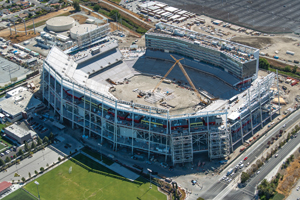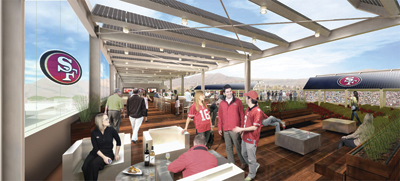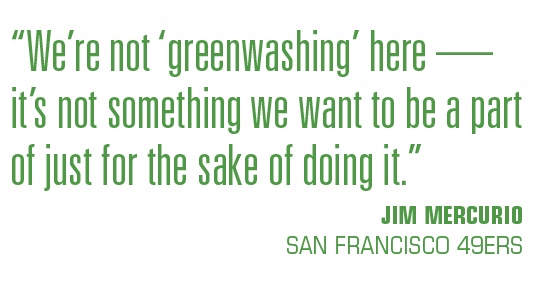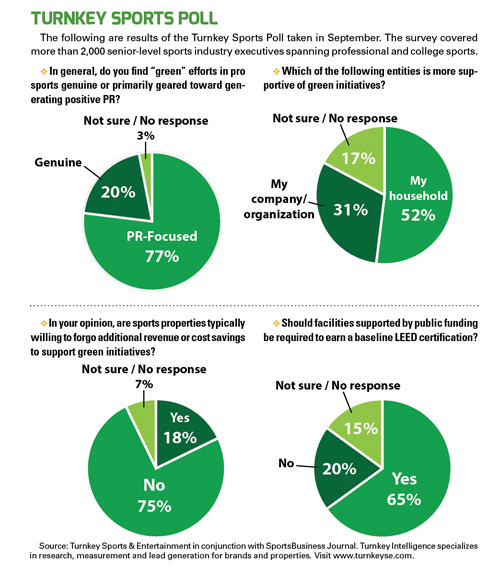Levi’s Stadium will set a new benchmark for green in sports after the San Francisco 49ers’ facility opens in August 2014.
The $1.3 billion project in Santa Clara is poised to become the first NFL stadium to earn LEED certification for new construction. It will prove to be a milestone for a building type that typically expends massive amounts of energy and creates huge amounts of waste on game days.
 |
Levi’s Stadium continues to take shape in Santa Clara, Calif.
Photo by: 111th Photography |
LEED, an acronym for Leadership in Energy and Environmental Design, is tied to sustainable design for buildings of all types. To be LEED-certified, buildings earn points in five categories: sustainable sites, water efficiency, energy, materials and resources, and indoor quality.
After the stadium opens, it must go through a review by the U.S. Green Building Council, the nonprofit administering LEED, before it is officially certified.
It looks to be a safe bet. As of late September, Levi’s Stadium had earned 42 points toward achieving LEED Gold status under Version 2.2, the old scoring system in effect in 2006 when the project was registered, said Robert Rayborn, vice president at Turner Construction.
Since that time, adjustments have been made to LEED’s scoring system weighed in favor of carbon footprint reduction, said Tambra Thorson, an LEED specialist and interior designer with HNTB, the stadium’s architect.
A minimum of 60 points is now required to earn LEED Gold for commercial projects, but the 49ers’ facility is grandfathered into the old scoring system, said Rayborn, the project’s co-director.
Regardless of the scoring system, LEED Gold is the second-highest level of certification under guidelines established by the U.S. Green Building Council.
In Santa Clara, the York family, the 49ers’ owners, drove the effort to go for Gold, according to Tim Cahill,
HNTB’s national director of design. The state of California requires that new construction projects reach LEED Silver at a minimum, one level above basic certification.
A few LEED points were automatic by meeting the state’s green building codes such as Title 24, which is connected to energy conservation. “Some of these things are mandated in California but the 49ers wanted to push it further on the board from the very beginning,” Cahill said.
The 49ers are privately financing most of the stadium construction and they will operate the facility on their own after leaving Candlestick Park, their home since 1971. Candlestick is owned and operated by the city of San Francisco.
By taking on greater responsibility for running the stadium, the York family felt it was important to push the envelope on sustainability to be a good corporate citizen, said Jim Mercurio, 49ers vice president of stadium operations and security.
“We’re not ‘greenwashing’ here — it’s not something we want to be a part of just for the sake of doing it,” said Mercurio, using a term to describe some businesses that spend more dollars on marketing sustainability over its actual implementation. “The Yorks believe in it.”
The construction site itself gave the 49ers’ project a head start on LEED. The 68,500-seat stadium taps into the Santa Clara Valley Water District that covers the entire south Bay Area. The district’s water recycling system removes the need to use fresh water to flush toilets and irrigate landscaped spaces. The system is already used to maintain a group of soccer fields behind the stadium and it will make a huge difference in water savings for the 49ers, Thorson said.
In addition, nearby parking lots tied to Great America theme park, city garages and a local college cover more than 21,000 spaces, eliminating the need to build new parking facilities. The project scores LEED points for not having to “lay down concrete” to build new lots, Mercurio said.
Stadium planners were also fortunate that the site is within walking distance of four public transit lines, including Amtrak and Caltrain, a commuter rail line that runs along the peninsula from San Francisco to San Jose. Those travel options also score LEED points. The 49ers’ research shows that up to 25 percent of their fans are expected to use public transportation to get to the games, doubling the 10 percent to 12 percent of fans who currently use it to get to Candlestick, Mercurio said.
 |
A green roof featuring native vegetation will help insulate the stadium’s suites and reduce stormwater runoff.
Photo by: San Francisco 49ers |
For those fans committed to going one step further to save energy, the stadium will have a bicycle valet service with storage space for 750 bikes. A major bike path leading to the stadium will be active on game days, Rayborn said.
At the stadium, the 20,000-square-foot green roof powered by a solar canopy above the suite tower on the building’s west side will feature a large display of native vegetation that will help insulate the suites and reduce stormwater runoff.
The 49ers are considering using the green roof to grow herbs to use in the stadium dishes served by Centerplate, the stadium’s concessionaire, Mercurio said. In that respect, it would cut down on the food materials trucked in from the East Coast, he said.
The solar canopy and the three solar array-covered bridges that fans will use to walk around the stadium will help offset energy consumed at the stadium during 49ers games. NRG Energy, the company installing the solar panels, is one of the stadium’s 10 founding partners.
One signature green element that has not drawn much attention is the redwood paneling inside the owner’s club, the stadium’s most exclusive premium space on the east side, opposite the suite tower.
The surface was reclaimed from the roof of an old zeppelin hangar at Moffett Field, a federal airstrip near Mountain View, Calif. The native material provides a point of reference to the region’s prolific redwood trees, an iconic symbol of Northern California.
“We didn’t want the stadium to be just about sports,” Thorson said. “The intent was to pick up on cultural pieces that influenced design.”







